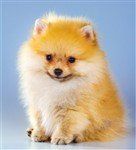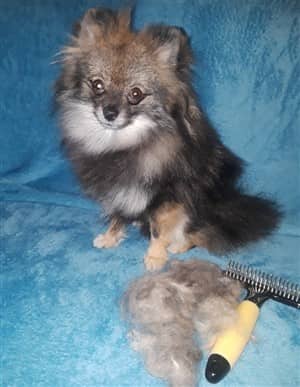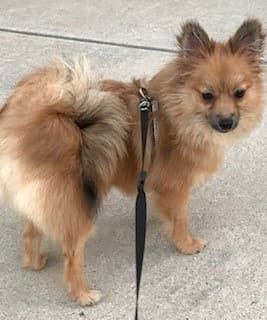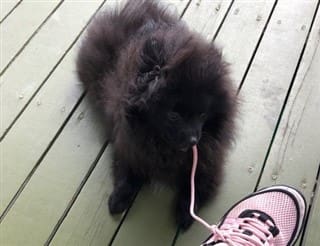Pomeranian Dos and Don'ts
Overview
There is a lot involved with taking care of a Pomeranian puppy or dog. Sometimes it can help to have a list of things that definitely should be done and things you should avoid doing. Here are the some of the most important Pomeranian dos and don’ts. How many are you following?
Please note:
PetPom is reader-supported, and some of the product suggestions on this page are affiliate links. As an Amazon Associate we earn from qualifying purchases. This is at no extra cost to you and helps us continue providing free, high-quality information.
Top 5 Pomeranian Dos
#1 Do stay on top of your Pom’s oral health.
When not properly removed, plaque and tartar eat away at tooth enamel and can lead to painful infections and periodontal disease which often results in damage to the gums and jawbone and eventual tooth loss that makes it difficult for a Pom to eat.
You can help avoid this with veterinary dental examinations and working at home to keep teeth clean. One of the most effective methods to clean a Pom’s teeth is to brush daily using either a properly-size toothbrush or a finger brush (which can be less invasive) and a fluoride-free, non-foaming canine paste. Something like the Nylabone Advanced Oral Care Dog Dental Kit
 contains everything you need to get started.
contains everything you need to get started.
Other methods to use alternately or in conjunction include dental sprays, supplements or additives that are added to drinking water, and dental chews like Greenies Teenie Natural Dental Treats .
.
#2 Do brush the coat often and with the right tools.
During times of heavy shedding, lots of dead fur will come out of the coat
if you use the right type of tool.
Photo courtesy of Dawn Johnson, Wolfpack Poms.
With their thick double coats of fur, most Pomeranians shed moderately year-round, with two heavy sheds twice per year. And un-spayed females often blow the coat after heat cycles.
Hairs shed mainly from the undercoat. For every hair that that makes its way out and falls to the ground, there are hundreds that remain trapped in the coat. If all that dead fur is not removed, it can block proper air flow, become encased with body oil and clog skin pores, and/or eventually get quite stinky.
And reasons to brush often are to keep hairs from getting matted which can be damaging to the coat, distributing body oils, and freeing debris from the coat.
So, brushing a Pomeranian
with the right tools is important.
For times of heavy shedding, a non-rotating rake tool like the Conair Pro Undercoat Rake with Medium Tooth
 (as seen in the photo above) works very well to de-shed a Pom’s coat. At all other times, a bubble-tipped or polished-tipped slicker brush, used in conjunction with a two-level comb, will get the job done. Aim to brush your Pom 2 to 3 times per week.
(as seen in the photo above) works very well to de-shed a Pom’s coat. At all other times, a bubble-tipped or polished-tipped slicker brush, used in conjunction with a two-level comb, will get the job done. Aim to brush your Pom 2 to 3 times per week.
#3 Do offer high-quality, all-natural foods.
Giving your Pomeranian a high-quality, all-natural food will help you avoid ingredients that are detrimental to their health including fillers which plump up food to make a dog feel full but offer little nutritional value, chemical preservatives which are known to cause allergic reactions (and one of them, BHT, is a known carcinogen in animals), and Red 40, Blue 2, Yellow 6 coloring dyes which are linked to neurological issues, cancers, and allergies.
MSG is flavor enhancer to avoid. This is linked to health issues ranging from allergies to brain lesions. It’s often added to dog food with little or no real meat and can be hidden in the list of ingredients under sodium or calcium caseinate, autolyzed or hydrolyzed yeast, yeast extracts and others. And generic meats and its by-products (seen listed as ‘poultry’, ‘meat’, ‘animal’) are derived from 4D animals (dead, dying, diseased, or disabled) including road kill and zoo animals of any kind.
So do offer a 4 or 5-star rated food that’s wholesome and all-natural. A good example is Wellness Complete Health for Small Breeds .
.
And if you are not confident in what you're feeding your Pom and feel it may be time for a change, you may wish to have a look at our more extensive overview of Pomeranian feeding guidelines
which covers the grain vs grain-free aspect, dry vs wet, and more.
#4 Do engage your Pom in regular exercise.
There are many benefits to routine moderate cardio exercise. It’s great for heart health, helps prevent a range of canine diseases including diabetes and some cancers, helps a dog maintain proper muscle mass, plays a role in reducing osteoarthritis (something 80% of dogs 8+ years contend with), keeps the metabolism functioning well, helps keep bowel movements regular, allows a dog to engage his senses for better emotional health, and can be an effective way for a dog to release pent-up energy (for better behavior later).
One of the best types of exercise is brisk walks. Aim for 2 daily walks of at least 20 minutes (and ideally 30+ minutes) each. And you can also keep your Pom moving by grabbing some colorful Mini Zanies
 to play rousing games of fetch.
to play rousing games of fetch.
#5 Do bring your Pom to the vet for wellness checks.
Wellness checks with the veterinarian are yearly exams that evaluate a dog’s overall health and screen for a wide range of common canine diseases and conditions. For seniors, exams are twice per year.
There are so many issues that can be detected long before obvious symptoms in which early diagnosis plays a vital role in successful treatment. With Pomeranians specifically, this includes such conditions as patella luxation, hip dysplasia, Legg-Calve-Perthes disease, trachea issues, osteoarthritis, and chronic degenerative valve disease (CVD) which is a heart disease that primarily affects toy and small breeds 5+ years old.
Your Pom will be weighed and their food intake and activity level will be discussed. And it's the perfect time to ask the vet any questions you've had on your mind.
Top 5 Pomeranian Don’ts
#1 Don’t allow your Pom to jump down from heights.
This little cutie is Peggy. She's being a trooper, but is sending a message that a
leg cast (with long confined bed rest followed by physical therapy) is no fun.
Photo courtesy of Jan Collins
There are two main concerns with small dogs jumping down from beds, sofas, and other furniture. One is repetitive strain injury due to chronic stress on the joints from the forelegs bearing the majority of body weight. The other is acute injury including pulls, tears, sprains, and bone fractures
that can happen simply from landing ‘wrong’ with the biggest risk linked to hard flooring surfaces (wood, tiles, etc.).
If your Pom has a habit of jumping off your bed, sofa, or other similar height, it’ll be time to consider a change. One option is to place pet stairs or a ramp like the Pet Gear Ramp Combo with supertraX
 and encourage your Pom to use them (often accomplished with training sessions using training treat rewards).
and encourage your Pom to use them (often accomplished with training sessions using training treat rewards).
#2 Don’t give your Pom unfiltered tap water.
It’s common for people to assume that their tap water is safe. But nothing could be further from the truth. In fact, the majority of public tap water contains a range of toxins, all of which can affect you and your Pom’s health.
In the US, at least a portion of every single state’s public drinking water has tested positive for Chromium-6, a known carcinogen; this affects 200 million Americans. As of 2016, 72.8% of US tap water contained fluoride, a known toxin to canines. Just a few of the other common concerns are barium, beryllium, chlorite, chloramines, and trichloroethane which are linked to everything from stomach irritation to organ damage.
What about safety regulations, you may ask? Well, a report by the Natural Resources Defense Council (NRDC) showed more than 80,000 violations of the Safe Drinking Water Act (SWDA) by US community water systems.
To ensure that your Pom’s drinking water is safe, options include offering bottled spring water, installing a filtering system to your kitchen sink, or using a device like the Aquagear Water Filter Pitcher
 that is impressively effective in cleaning out contaminants as the water is being poured.
that is impressively effective in cleaning out contaminants as the water is being poured.
#3 Don’t use a collar when your Pom is on a leash.
Collars place tension on the neck. But a harness like this one keeps
the neck free and can save your Pom from a chronic, painful condition.
Photo of Datla courtesy of Lyssa.
Pomeranians are one of the toy breeds most prone to collapsed trachea. It is a painful and serious genetic condition in which the c-shaped rings of cartilage surrounding the trachea (windpipe) are weak, often eventually resulting in a collapse inward (varying from grade 1 to grade 4). The average age of diagnosis is 6 years old.
Stress on the trachea via a dog collar can speed the degeneration of tracheal cartridge and exacerbates the condition. This is why a collar should never be placed on a Pomeranian that’s on a leash. A harness should be used instead, which displaces pressure over the chest, back, and shoulders.
If you think that a harness may be a hassle, you’ll be happy to know that some, like the Puppia Soft B Harness Vest , are super-easy to place on (nothing has to go over the head), are comfortable, and can make it much easier to control your Pom while walking.
, are super-easy to place on (nothing has to go over the head), are comfortable, and can make it much easier to control your Pom while walking.
#4 Don’t use just any old shampoo.
The majority of dog shampoos on the market today contain ingredients that can cause allergic reactions, excessive dryness, and/or irritation. Even worse, some ingredients are linked to a wide range of serious health issues including organ damage and cancer.
This is mainly due to pet product companies using inexpensive ingredients. For example, using phthalates (common in scented shampoo) instead of natural fragrances like rosemary oil. And sulfates (used as soaping agents) including sodium lauryl sulfate (SLS) which is linked to organ system toxicity and sodium laureth sulfate (SLES) which is linked to cancer, organ toxicity, neurotoxicity, skin irritation, and hormone disruption.
Another issue is coloring dyes and synthetic fragrances which are the frequent culprits of allergic reactions; some are linked to organ damage and cancers.
This can all be avoided by carefully reading the list of ingredients on any shampoo, conditioner, coat spray, or other topical product that you use on your Pom. Look for strictly all-natural options such as Earthbath Oatmeal & Aloe Shampoo
 (a great choice for this breed due to their sensitive skin) with plant-based cleansers and natural fragrances, and with zero additives.
(a great choice for this breed due to their sensitive skin) with plant-based cleansers and natural fragrances, and with zero additives.
#5 Don’t stop puppy-proofing the house & yard, no matter your Pom's age.
Dogs of any age can and do mouth things, often just
to answer the question of ‘what is this?’.
Rascal, photo courtesy of Ruth Glatt.
This is a task that often falls by the wayside, but should be done indefinitely throughout a Pom's entire adult life.
Dogs mouth, and then can swallow, a wide range of dangerous items simply out of curiosity. Accidently ingestion of medications, human food that’s toxic to dogs, pet products (like flea treatments), household cleansers, insecticides, and plants account for 214,000 cases of pet poisoning every year in the U.S.
Items that small dogs have swallowed that required emergency surgery include fishing hooks, sewing needles, watch batteries, fish gravel, and coins. And electric cord bite injuries are a real concern.
To keep things safe, make it part of your weekly routine to go over the floor and any accessible areas to check for small objects. If you see anything drop, pick it up right away. Place cleaning solutions, bathing products, lawn care chemicals, etc. out of reach. Use child-proof latches on lower cabinets. Configure electrical cords to be out of reach or use coverings like the PetCords Cord Protector . Keep lids tightly secured to trash bins. Always keep you purse and/or gym bag out of reach. Check the yard for hazards.
. Keep lids tightly secured to trash bins. Always keep you purse and/or gym bag out of reach. Check the yard for hazards.
Recap
Here’s a summary of the top dos and don’ts for Pomeranians:
- Do stay on top of your Pom’s oral health.
- Do brush the coat often and with the right tools.
- Do offer high-quality, all-natural foods.
- Do engage your Pom in regular exercise.
- Do bring your Pom to the vet for wellness checks.
- Don’t allow your Pom to jump down from heights.
- Don’t give your Pom unfiltered tap water.
- Don’t use a collar when your Pom is on a leash.
- Don’t use any old shampoo.
- Don’t stop puppy-proofing the house & yard.
Do you have your book?
If you have a Pom, you'll want to check out our book: PetPom's GIANT Book of Pomeranian Care. It's the most comprehensive book of its kind and will be your guideline for your Pom's entire life.
You may also like:
How to Keep a Pomeranian Clean
- Helpful tips to keep a Pom looking tidy and smelling nice in between baths.
How to Keep a Pomeranian Safe
- The top 15 ways to keep your Pom super safe from dangers many owners do not even think about. How many are you doing?
Pomeranian is Scared of Loud Noises
- From thunder to fireworks and even the vacuum cleaner, some dogs are terribly afraid of loud sounds; learn why this is and exactly how to help your little guy or gal.
How to Fix Tear Stains on a Pomeranian
- If your Pom has discoloration under or around the eyes, it'll take a bit of work but these can be fully removed.






